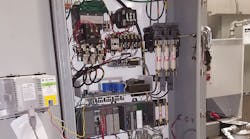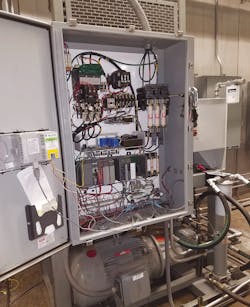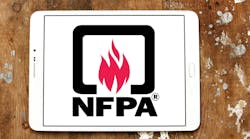A common issue I encounter when evaluating a facility is the perception that “I don’t need electrical safety training because I call in an electrician to deal with anything over 48V.” Although there is nothing wrong with this statement, there is potential danger in what is not being said. A key principle when working around electrical equipment is not only evaluation of the hazards of the system you are working on, but also evaluation of the hazards of the systems to which you are exposed.
NFPA 70E defines exposed in Art. 100 as follows:
“Exposed (as applied to energized electrical conductors or circuit parts). Capable of being inadvertently touched or approached nearer than a safe distance by a person. It is applied to electrical conductors or circuit parts that are not suitably guarded, isolated, or insulated.”
I can’t count the times that I have shadowed a worker who only works on control circuits and PLCs and discover they are regularly working on these systems in an enclosure that also has energized 480VAC equipment. It is true that they are only working on systems rated less than 50V, but they are being exposed to serious shock and arc flash hazards due to the other circuits that are energized and exposed inside the same enclosure. These employees certainly need electrical safety training to understand and recognize these circumstances and become knowledgeable of methods to ensure they remain safe while performing these tasks.
Sec. 110.2(A) of NFPA 70E addresses the general requirement for electrical safety training:
“The training requirements contained in 110.2(A) shall apply to employees exposed to an electrical hazard when the risk associated with that hazard is not reduced to a safe level by the applicable electrical installation requirements. Such employees shall be trained to understand the specific hazards associated with electrical energy. They shall be trained in safety-related work practices and procedural requirements, as necessary, to provide protection from the electrical hazards associated with their respective job or task assignments. Employees shall be trained to identify and understand the relationship between electrical hazards and possible injury.”
When determining needs for electrical safety training, the training and electrical personal protective equipment (PPE) should reflect the hazards to which the employee is exposed. It is not enough to think about the discrete systems on which employees are working. One must also consider the location of the systems and exposure to additional electrical hazards near the work at hand.
Northcott is a professional engineer licensed in the state of Tennessee and a senior power engineer with Jacobs Technology, Inc., in Tullahoma, Tenn. He is also an NFPA 70E compliance subject matter expert, a principle member of the NFPA 70B Committee, electrical safety trainer, certified maintenance and reliability professional, and certified reliability leader. He can be reached at [email protected].
From the Author
Over the last several years, I have been blessed with the opportunity to visit many commercial, industrial, and government facilities across the United States to provide electrical safety training and audits. During that time, I have come to realize that there are several common misunderstandings or misapplications that must be addressed regardless of the type or location of the facility. This “Safety Sense” department will address these issues in a short format, addressing frequently asked questions. If there are topics you would like covered, please email me at [email protected]





